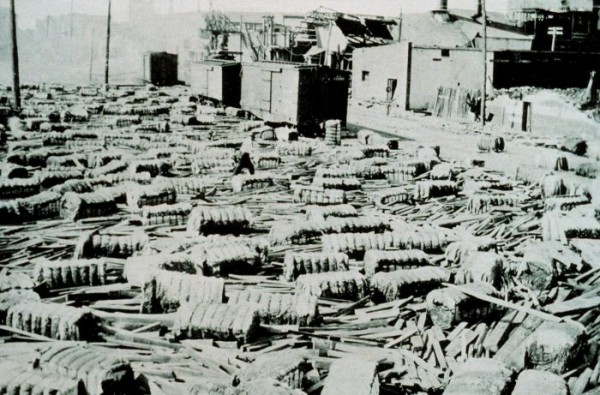The Mobile Hurricane of 1916
Cotton bales and other debris on tracks of Southern Railway in Mobile From: “The Floods of July, 1916”, copyright 1917, Southern Railway Company. Library Call Number F215.F55 1917. Courtesy NOAA.
Early on the morning of July 3, 1916, The Mobile Register ran a story about the first hurricane of the year. The U.S. Weather Bureau central office in Washington had sent a telegram to weather offices along the Gulf Coast the day before. The message had warned of a tropical cyclone near latitude 17N, longitude 84W, or north of Swan Island. It was moving north or northwest.
On July 4th, the weather in Mobile was ordinary. There was a thunderstorm around 3 in the afternoon, but the barometer was slowly falling, telling of the approaching storm. Vessels were advised to remain in port, but most of the steamers and tugs were at rest anyway, because of the Independence Day holiday. There was talk about the storm in the Gulf, but no one took it very seriously. After all, early season storms were generally not very bad. At 9:13 p.m., a storm warning arrived by telegraph and it was immediately disseminated.
The storm headlined the Mobile Register the next morning. The barometer had begun a free fall and the wind started to pick up by 4:30 a.m. at 4:55 a.m., winds were averaging 36 mph. By 10:07 a.m., they were running 44 mph. By noon, the wind was 60 mph. They would peak at 106 mph.
The tide that morning had actually been below normal, but it began to rise during the morning. At 11 a.m., Mobile’s Chief of Police was dispatched to warn businesses along the riverfront that a significant storm tide was expected. Around 4:45 p.m., the water rose over the St. Francis Street Wharf. The storm was at its peak. The barometer had fallen to 28.92 inches at 3:45 p.m. The surge quickly inundated Water Street. Eventually, areas four blocks from the riverfront would be under water. The 11.6 foot surge height still is the record for Mobile. Hurricane Katrina came close at 11.46 feet at the Alabama State Docks.
The barometer at Fort Morgan dropped to 28.38 inches. At Pascagoula, the station was in the eye for 20 minutes between 4 and 5 p.m. Mobile picked up 8.56 inches of rain. At Pensacola, winds caused much of the destruction with a lower storm surge. The damage was heavy along the coast, totaling $3 million. Four people lost their lives in the July 1916 hurricane.
The dying tropical cyclone would become famous for record setting rainfalls well inland when the storm stalled over the South, including here in Birmingham, where 8.84 inches fell on July 8th. Another tropical system later in the month led to the Magic City’s record monthly rainfall as 20.16 inches fell, a record to this day.
A second strong hurricane would affect the Central Gulf Coast in October, hitting the Pensacola and Mobile areas hard again with even stronger winds, but less storm surge because of a faster forward movement.
Category: Uncategorized

















Comments (3)
Trackback URL | Comments RSS Feed
Sites That Link to this Post